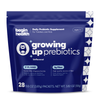What is a Healthy Microbiome in Kids?
share this article

The microbiome, the community of microorganisms living in our bodies, plays a critical role in overall health, particularly in kids. A healthy microbiome supports digestion, strengthens the immune system, and even influences mood and behavior. Understanding what constitutes a healthy microbiome in kids and how to nurture it is essential for parents aiming to promote their kiddos' well-being. In this blog, we’ll review the components and the factors that contribute to a healthy microbiome in kids.
Daily reads to help your little ones lead happier and healthier lives.
Join the
Happy Gut Club
Components of a Healthy Microbiome
A healthy microbiome is characterized by diversity and balance of good gut bacteria. A balanced gut microbiome means that beneficial bacteria outnumber the harmful ones, contributing to a well-functioning digestive and immune system.
-
Diversity of Bacteria: Diversity in the microbiome means having a wide variety of bacterial species. A diverse microbiome is more robust and better at preventing disease. According to a study published in Nature, greater bacterial diversity is associated with improved metabolic health and immune function in kids [1]. This diversity helps in efficiently breaking down food, producing essential nutrients, and protecting against pathogens.
-
Balanced Environment: Balance refers to the right proportions of different bacterial species. When harmful bacteria outgrow the beneficial ones, it can lead to health issues such as infections, allergies, and digestive problems. Research in the Journal of Allergy and Clinical Immunology found that an imbalance in the gut microbiome is linked to an increased risk of developing allergies and asthma in kids [2]. Maintaining a balance helps in managing inflammation and supports a strong immune response.
-
Gut Resilience: A resilient microbiome can quickly recover from disruptions caused by factors such as antibiotics, illness, or diet changes. A study in Cell Host & Microbe emphasized that resilience in the microbiome is crucial for long-term health, as it allows the gut ecosystem to return to its healthy state after disturbances [3].
Factors Influencing a Healthy Microbiome
Several factors contribute to the development and maintenance of a healthy microbiome in kids:
-
Diet: A diet rich in fiber, fruits, vegetables, and fermented foods promotes a healthy microbiome. High-fiber foods act as prebiotics, feeding the beneficial bacteria. Fermented foods like yogurt and kefir introduce probiotics, which add beneficial bacteria to the gut. The American Journal of Clinical Nutrition reported that kids who consume a varied diet rich in fruits and vegetables have a more diverse and balanced gut microbiome [4].
-
Breastfeeding: Breast milk contains beneficial bacteria and prebiotics that help establish a healthy microbiome in infants. A study in JAMA Pediatrics found that breastfed infants have higher levels of beneficial bacteria like Bifidobacteria and Lactobacilli compared to formula-fed infants [5].
-
Antibiotics: While antibiotics are sometimes necessary, they can disrupt the microbiome by killing both harmful and beneficial bacteria. It's important to use antibiotics judiciously and under medical supervision. Research in Nature Reviews Microbiology highlighted that the overuse of antibiotics can lead to long-term imbalances in the gut microbiome, emphasizing the need for cautious use [6].
-
Environment: Exposure to diverse environments and outdoor activities can help enhance microbiome diversity. Kids who spend more time outdoors and interact with pets tend to have a more diverse microbiome. A study in. Frontiers in Microbiology found that exposure to a variety of microorganisms in natural environments contributes to a healthier gut microbiome in kids [7].
-
Probiotics and Prebiotics: Probiotics are live beneficial bacteria, and prebiotics are fibers that feed these bacteria. Including both in a kid's diet can support microbiome health. The Journal of Pediatric Gastroenterology and Nutrition demonstrated that probiotics and prebiotics positively influence gut health and improve digestive function in kids [8].
Summary
A healthy microbiome in kids is characterized by diversity, balance, and resilience. Factors such as diet, breastfeeding, judicious use of antibiotics, environmental exposure, and the inclusion of probiotics and prebiotics play crucial roles in maintaining this balance. Promoting a healthy microbiome is essential for overall well-being because it supports digestion, strengthens the immune system, and impacts mood and behavior.
















